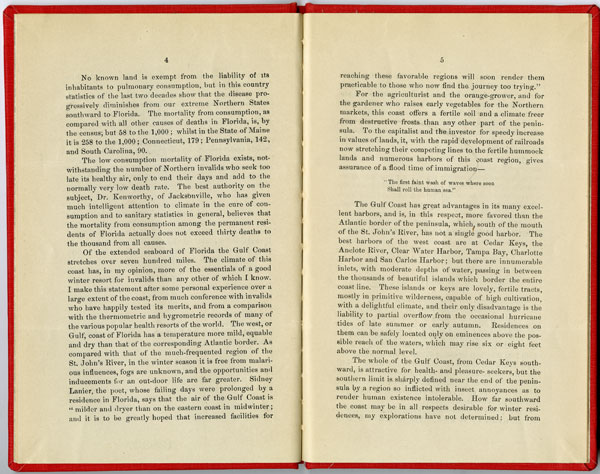"A Winter Climate for Invalids"
Date: 1883
Series: 614.42 L666 - "A Winter Climate for Invalids;:
The Gulf Coast of Florida.
(Page 3 of 7)
Transcript
[page 4]
4
No known land is exempt from the liability of its
inhabitants to pulmonary consumption, but in this country
statistics of the last two decades show that the disease pro-
gressively diminishes from our extreme Northern States
southward to Florida. The mortality from consumption, as
compared with all other causes of deaths in Florida, is, by
the census, but 58 to the 1,000; whilst in the State of Maine
it is 258 to the 1,000; Connecticut, 179; Pennsylvania, 142,
and South Carolina, 90.
The low consumption mortality of Florida exists, not-
withstanding the number of Northern invalids who seek too
late its healthy air, only to end their days and add to the
normally very low death rate. The best authority on the
subject, Dr. Kenworthy, of Jacksonville, who has given
much intelligent attention to climate in the cure of con-
sumption and to sanitary statistics in general, believes that
the mortality from consumption among the permanent resi-
dents of Florida actually does not exceed thirty deaths to
the thousand from all causes.
Of the extended seaboard of Florida the Gulf Coast
stretches over seven hundred miles. The climate of this
coast has, in my opinion, more of the essentials of a good
winter resort for invalids tan any other of which I know.
I make this statement after some personal experience over a
large extent of the coast, from much conference with invalids
who have happily tested its merits, and from a comparison
with the thermometric and hygrometric records of many of
the various popular health resorts of the world. The west, or
Gulf, coast of Florida has a temperature more mild, equable
and dry than that of the corresponding Atlantic border. As
compared with that of the much-frequented region of the
St. John's River, in the winter season it is free from malaria-
ous influences, fogs are unknown, and the opportunities and
inducements for an out-door life are far greater. Sidney
Lanier, the poet, whose failing days were prolonged by a
residence in Florida, says that the air of the Gulf Coast is
"milder and dryer than on the eastern coast in midwinter;
and it is to be greatly hoped that increase facilities for
[page 5]
5
reaching these favorable regions will soon render them
practicable to those who now find the journey too trying."
For the agriculturist and the orange-grower, and for
the gardener who raises early vegetables for the Northern
markets, this coast offers a fertile soil and a climate freer
from destructive frosts than any other part of the penin-
sula. To the capitalist and the investor for speedy increase
in values of lands, it, with the rapid development of railroads
now stretching their competing lines to the fertile hummock
lands and numerous harbors of this coast region, gives
assurance of a flood times of immigration-
"The first faint wash of waves where soon
Shall roll the human sea."
The Gulf Coast has great advantages in its many excel-
lent harbors, and is, in this respect, more favored than the
Atlantic border of the peninsula, which south of the mouth
of the St. John's River, has not a single good harbor. The
best harbors of the west coast are at Cedar Keys, the
Ancolte River, Clear Water Harbor, Tampa Bay, Charlotte
Harbor and San Carlos Harbor; but there are innumerable
inlets, with moderate depths of water, passing in between
the thousands of beautiful islands which border the entire
coast line. These islands or keys are lovely, fertile tracts,
mostly in primitive wilderness, capable of high cultivation,
with a delightful climate, and their only disadvantage is the
liability to partial overflow from the occasional hurricane
tides of late summer or early autumn. Residences on
them can be safely located only on eminences above the pos-
sible reach of the waters, which may rise six or eight feet
above the normal level.
The whole of the Gulf Coast, from Cedar Keys south-
ward, is attentive for health- and pleasure-seekers, but the
southern limit is sharply defined near the end of the penin-
sula by a region so inflicted with insect annoyances as to
render human existence intolerable. How far southward
the coast may be in all respects desirable for winter resi-
dences, my explanations have not determined; but from

 Listen: The Blues Program
Listen: The Blues Program
